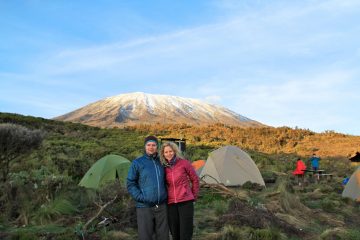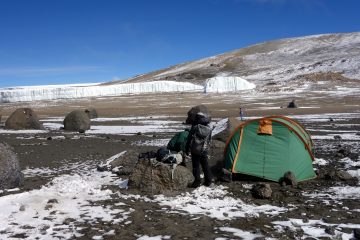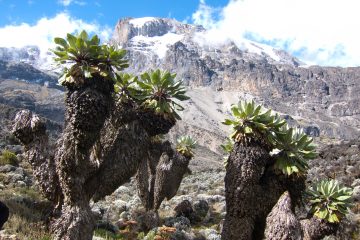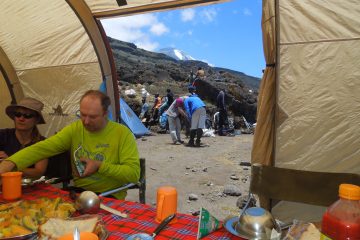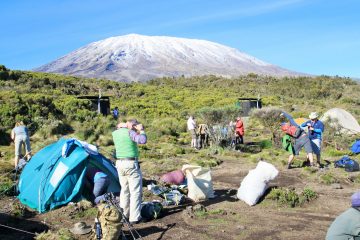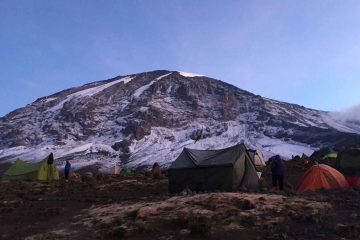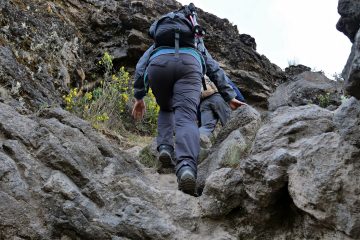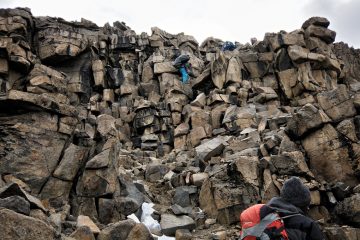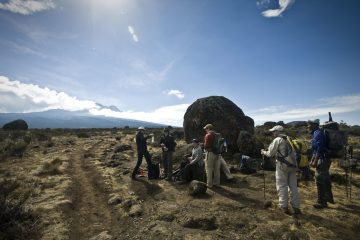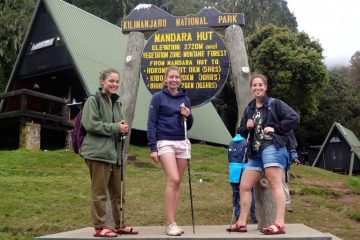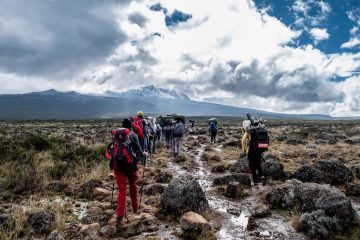Best time for Climbing Kilimanjaro.
The warm and dry seasons in Tanzania offers the best weather for climbing Mount Kilimanjaro. There are two main climbing seasons in Tanzania, the dry season and the wet season: The dry seasons which offer the best climbing weather for climbing Mount Kilimanjaro occur during the dry months of mid-December up to mid-March, and early June up to mid-October. However, between Mid-December and mid-March, it is usually dry and warm making it the best time to climb Kilimanjaro, while early June through mid-October is generally dry and cool which is also good. The peak season for tourists coming to Kilimanjaro is during the dry and warm season, around Christmas because around this time, the weather is conducive for scaling the mountain and the temperatures are favourable.
There are two wet seasons in Tanzania’s Mount Kilimanjaro namely; November to December and March to May. The months between August to October are the driest and the best for climbing the mountain. Rainfall decreases rapidly with an increase in altitude; average precipitation is 2,300 millimetres (mm) in the rain forest zone (at 1,830 m), 1,300 mm at Mandara hut on the upper end of the rainforest zone (2,740 m), 525 mm at Horombo hut in the moorland (3,718 m), and less than 200 mm at Kibo hut (4,630 m), giving it semi-arid to arid conditions that seem like a desert. The prevailing winds, influenced by the trade winds, are from the southeast. North-facing slopes receive far less rainfall.
January to March are the warmest months. Above the altitudes of 4,000m, the weather conditions on Mount Kilimanjaro reach extreme levels with temperatures maintain a considerable condition. Mist frequently covers much of the massif even with little dense cloud cover.
East African peaks of Mount Kilimanjaro, Mount Kenya, Rwenzori mountains and Mount Meru are so high, isolated and most of them free-standing, unlike other ranges that they create their own weather. After a clear morning, at about 10:00 am thick cloud engulfs their summits (4,000 meters and beyond), covering the summits till late, until they clear during the night.
During the dry seasons, precipitation is unpredictable but rain could fall out of nowhere. The wind blows occasionally but when it does it is usually strong and winds.
Mount Kilimanjaro is an all-weather mountain as most of the routes do not require any technicality to climb but it is least favourable to climb in the wet and cold months. Technical routes, on the other hand, depend more on the weather.
Mount Kilimanjaro Routes that face south are better off used in the months of December, January, and February while routes that face north are best done in the months of July, August, and September. The same is contrary for Ice climbs where: south-facing routes are best attempted in the months of July, August, and September; north-facing routes are best attempted during the months of December, January, and February.
Although all these East African peaks sit astride the equator, they can be extremely cold places, especially during the night. Generally, expect temperatures at night and in the early morning at the 4,600-meter level to be as low as minus 5 degrees Celsius (23 degrees Fahrenheit).
Temperatures during the day are favourable than during the night as you can wear shorts as far as the top campsites of (Kibo, Barafu on Kilimanjaro and Saddle hut on Mount Meru, where midday temperatures can reach 10 degrees Celsius (50 degrees Fahrenheit).
However, anyone climbing above the 4,600-meter level should have several thermal layers of clothing. Also, be prepared to feel cooler at noon than you do at, say, 9:00 am or 4:00 pm. The moisture in the clouds that swirl around the summits during the day makes the air feel much colder than it really is.
Effect of the (Monsoon) Trade Winds on Kilimanjaro Weather
How are rain and snow formed on Mount Kilimanjaro?
The trade winds otherwise known as the Monsoon winds are responsible for causing rain on Mount Kilimanjaro. They carry along with moisture from across the ocean and as they rise, the mountain becomes a sort of barrier making the moisture condense after cooling causing rain and snow.
The long rain season in the Kilimanjaro region between the months of March and May is caused mainly by trade winds that move from the southeast. These southerly winds from the Indian Ocean which is located South East of Mount Kilimanjaro carry moisture, causing the lower slopes to have rain and the summit to have snow.
The slopes located on the southern side of the mountain receive the most precipitation and rainfall.
The much drier winds that originate from the Northeastern side cause the ‘short rain’ seasons during the month of November Since the winds do not travel across the ocean, they carry less moisture as compared to the winds that originate from the South East. Short rains mostly occur on the Northern slopes of the mountain.
The pattern of the trade winds around the equator is shown below. As the sun moves between the tropics of cancer and Capricorn the dominant wind pattern over Kilimanjaro changes so that although the temperature varies very little there are big changes in rainfall.
The wettest months of April and May on Mount Kilimanjaro are a result of dominant winds that originate from the South-East across the Indian ocean. The fact that they travel across the Indian ocean means that they carry abundant moisture which condenses and cools to form a thick cloud cover and eventually rain and snow.
Apart from these winds, there are many factors that influence the weather on Mount Kilimanjaro like altitude and the climatic zones of the mountain.
Mount Kilimanjaro’s Rainfall
How rainfall forms on Mount Kilimanjaro
Mount Kilimanjaro acts as an obstacle to travelling moisture-laden air masses from the Indian ocean in the South East and also the air masses from the North East forcing them to rise over the three peaks, Shira, Mawenzi and Kibo. When this happens, air temperatures drop; as the water vapour cools, forming fog and eventually rain and snowfalls mostly on the windward side of Mount Kilimanjaro. When the same air mass descends on the other side of Mount Kilimanjaro, it contains a small amount of moisture. As a result, a “rain shadow” or dry climate develops on the other side of the mountain where the Northern slopes reside.
Kilimanjaro Routes & Weather
Choosing a route to climb Mount Kilimanjaro sometimes depends on the month that you choose to travel. Below is our advice concerning the routes to choose in different weathers.
Best Routes for Wet weather in Kilimanjaro:
The wet months of April, May and November on Kilimanjaro come with some rain, the best route to choose for climbing Mount Kilimanjaro during the wet months is the Rongai route which approaches the mountain from the northern side which lies under the rain shadow of Mount Kilimanjaro as opposed to the southern slopes that receive large amounts of rainfall at this time of the year.
Beast Routes for the Dry Weather of Kilimanjaro
The driest months of June through to October occur on Kilimanjaro mainly because anti-trade winds originating from the northeast carry very little moisture forcing the South-east winds to descend hence the mountain has no cloud cover or enough precipitation for the rain to fall at these times of the year. The best routes for the dry season on Mount Kilimanjaro are the Machame Route and Lemosho Route.
November is the short rain season on Mount Kilimanjaro whereby these light rains are caused by monsoon winds that carry some little amount of moisture, originating from the North East. This results in some light rains on the Northern slopes of the mountain.
The best weather for climbing Mount Kilimanjaro
The best weather for trekking on Mount Kilimanjaro is during the months of January to March and June to October.
Why are these the best months to climb Mount Kilimanjaro? The months of January to March are colder but dry. The mountain during these months is usually quiet and experiences less traffic from climbers. Because of the cold, the routes are less frequented but it is a great time to enjoy mountain climbing at this time.
June to October months offer the best weather for climbing Mount Kilimanjaro. This is the perfect time to climb the mountain as it is mostly warm and dry in the Kilimanjaro region. Also during these months, it is the summer holidays in both Europe and North America and many climbers opt for this time of the season. There are more quiet and tranquil routes however on the mountain during this peak season when everybody wants to come to Tanzania to climb Mount Kilimanjaro in this good weather. The Northern Circuit route is the best option if you want to avoid the masses that approach the mountain from the southern slopes.
Wettest and worst time to climb Kilimanjaro
The least favourable months to climb Kilimanjaro is during the months of April, May and November as they are the wettest months and not enjoyable for trekking unless you have waterproof gear.
The coldest months on Kilimanjaro
December and March are the coldest months in the Kilimanjaro region and snowfall is more than likely to happen. These are good months to climb Mount Kilimanjaro but you will have to layer your clothing properly for extra warmth.
Summary of weather conditions on Kilimanjaro
January to March
The weather in the first few months after the short rainy season is generally warm and dry. Away from the high season so relatively quiet, this is one of our favourite times to climb Kilimanjaro. Dry and quiet
April and May
The long rainy season in Tanzania normally occurs in April and May although it has become more unpredictable in recent years. If you don’t mind the rain you can have the mountain pretty much to yourself. And bear in mind you can nearly always get a good discount in this period. Long rainy season
June to early November
June to early November are the driest months for your Kilimanjaro climb but particularly during August to October means the mountain is very busy. The shoulder months of June and July and early November are good compromises if a little rain doesn’t deter you. Dry but busy
November to mid-December
The short rainy season normally starts towards the back end of November and continues for 3-4 weeks. Generally, rain is less persistent than in the main rains and so this is a good time to be on the mountain without the crowdsShort rainy season
Weather forecast for Kilimanjaro
Since Mount Kilimanjaro has several climatic zones, you cannot just summarize the weather and temperature for the whole mountain as one. The weather ranges from the base to the summit. Temperatures also range from hot to freezing cold. To summarize, climbing Mount Kilimanjaro from the base to the summit can be compared to a journey from the equator to the north pole in a matter of a few days.
Mount Kilimanjaro has five climatic/vegetation/ecological zones, each with an elevation of about 3,280 feet (1,000 m). as you climb up higher the mountain the temperatures drop, rainfall decreases and flora/fauna become scarcer until there is no more. Below is the weather chart for Moshi, the closest town to Mount Kilimanjaro and also the most important place from where we organize our climbs.
| Average Temperature, Humidity and Precipitation in Moshi, Tanzania |
| Month | Low (F) | Average (F) | High (F) | Humidity (%) | Rainfall (in) |
| January | 64 | 78 | 92 | 58 | 1.4 |
| February | 64 | 78 | 92 | 57 | 2.0 |
| March | 66 | 78 | 90 | 63 | 4.7 |
| April | 67 | 76 | 85 | 73 | 13.8 |
| May | 65 | 72 | 79 | 77 | 9.3 |
| June | 62 | 70 | 78 | 72 | 1.5 |
| July | 60 | 69 | 78 | 69 | 1.0 |
| August | 60 | 70 | 80 | 66 | 0.7 |
| September | 60 | 71 | 83 | 61 | 0.6 |
| October | 62 | 75 | 88 | 57 | 1.0 |
| November | 64 | 76 | 89 | 57 | 2.5 |
| December | 64 | 77 | 90 | 60 | 2.1 |
As indicated in the weather chart for Moshi in the Kilimanjaro region, the months of January and February are the warmest, April and May are the wettest months while the coldest months have got to be the months of June and July. The driest months are from August to September. These weather conditions for Moshi, also reflect Mount Kilimanjaro.
Mount Kilimanjaro temperature
Since Mount Kilimanjaro lies close to the equator, the mountain does not experience dramatic temperature changes every month but due to the high altitudes of the mountain elevation is mostly the determining factor for weather and temperature change. The time of day on the mountain can also influence the temperature changes
At the foot slopes of Mount Kilimanjaro, the temperature ranges from 70 to 80 degrees Fahrenheit (21 to 27 degrees Celsius) on average, gradually dropping as you climb higher up through the other climatic zones.
By the time you reach the summit at Uhuru peak the temperature drops to a low 20- and -20 degrees Fahrenheit (-7 to -29 degrees Celsius) during night time. Mount Kilimanjaro is so tall that it can create its own weather, you should be prepared to face rain and cold nights when climbing the mountain as the weather on Mount Kilimanjaro can be unpredictable at times.
Kilimanjaro Weather through the Climate Zones
The weather changes as you climb higher mount Kilimanjaro’s different climatic zones.
Cultivation Zone:
Altitude: 2,600 to 6,000 ft (800 to 1,800 m)
Precipitation: 20 to 70 in (500 to 1,800 mm)
The cultivation is the area that encircles the mountain. It surrounds the foot slopes of Kilimanjaro that consist of cultivated farmland. The fertile volcanic soil at the vicinity of Mount Kilimanjaro and also present in the cultivation zone is ideal for farming, the cultivation zone gets abundant rainfall for farming. This zone is characterized by moderate temperatures and is the first zone you pass on your way to your starting point for trekking.
Forest Zone:
Altitude: 6,000 to 9,200 ft (1,800 to 2,800 m)
Precipitation: 79 to 40 in (2,000 to 1,000 mm)
The forest zone of Kilimanjaro receives abundant of moisture, precipitation and water in the form of streams and springs from the upper slopes of the mountain. This zone is characterized by warm and humid weather with mists existing under the heavily forested zone of canopies.
The forest zone is almost always wet and muddy as it rains almost constantly here.
Heath/Moorland Zone
Altitude: 9,200 to 13,200 ft (2,800 to 4,000 m)
Precipitation: 51 to 21 in (1,300 to 530 mm)
The next zone after traversing the thick forest of the rainforest zone of Kilimanjaro. The Heath & Moorland Zone is characterized by giant heathers and vast grassland. It is usually windy and rainy sometimes at a minimum level even though this region has lower humidity levels than the forest zone.
The weather of Kilimanjaro’s heath and Moorland zone has warm temperatures during the day and colder at night. The terrain here is drier than the forest zone. It is either too sunny during the day or extremely cold at night, never in between.
Alpine/High Desert Zone:
Altitude: 13,200 to 16,500 ft (4,000 to 5,000 m)
Precipitation: 10 in (250 mm)
The alpine zone is desert-like and arid with patches of drought-tolerant plants scattered here and there. It is even windier here but rainfall decreases here.
During the day it is usually warm but come nighttime, temperatures become quite chilly. You will most probably be spending your nights camping above the clouds, giving you a great view of the stars, perfect for Mount Kilimanjaro’s star gaze.
Read about stargazing on Mount Kilimanjaro.
Be wary though as the air becomes thinner in this alpine desert zone and the trails are filled with dust.
Arctic Zone:
Altitude: 16,500+ ft (5,000+ m)
Precipitation: 4 in (100 mm)
The arctic zone is the last climatic and ecological zone on Mount Kilimanjaro. Consisting of the summit and peak area of the mountain, the arctic zone of Mount Kilimanjaro is located at an elevation of over 16,000 ft.
The arctic zone also referred to as the summit zone, is characterized by minimal precipitation and rain falls in the form of snow, a cold desert with rock outcrops, glaciers and terrain filled with volcanic scree.
This zone falls under “extreme altitude”, the thinning of air in the atmosphere at these high altitudes results in the oxygen levels here being half of the normal oxygen levels at sea level, about 49% to be precise. Temperatures here fall to subzero, below-freezing points as it is evident by the presence of snow, ice and glaciers that dominate the terrain of the arctic zone. It may be freezingly cold in this zone but the sun shines here harshly that is why we recommend that you carry sunscreen when you climb Mount Kilimanjaro.
The arctic zone comes with harsh weather conditions, strong winds and very low temperatures, layering of clothing is strongly advised to keep you warm.
Kilimanjaro Weather Chart
| Month | Jan | Feb | March | April | May | June | July | Aug | Sept | Oct | Nov | Dec |
| Weather | sun | sun | rain | cloud | cloud | rain | sun | sun | sun | rain | cloud | sun |
Kilimanjaro Weather Month by Month
The Long Dry Season: June to September
The long dry season offers suitable weather to climb Mount Kilimanjaro. Though temperatures during this time of the year may be cooler than during the months of January and February which also happens to the short-dry period, rainfall is very scarce hence giving an all-round amazing season to climb Mount Kilimanjaro.
Climbing Kilimanjaro in July to September
The Short Wet Season: October to December
October and December is the short rain season. Short rains can be quite unpredictable as you cannot exactly tell when it may rain or not. It is not advisable to climb when it has started raining.
Climbing Kilimanjaro in December
The Short Dry January to February
Late January to mid-February is the perfect time to climb Mount Kilimanjaro. It is dry and warm during this season, even warmer than the months between June and October.
Climbing Kilimanjaro in January and February
The Long Wet Season: March to May
March to May is the long rain season which is as a result of the trade winds that blow from the Indian Ocean then condense on the mountain to form precipitation and rainfall. During these months, roads are impassable, the trails are muddy, slippery and wet due to the heavy rainfall. It would not be wise to climb Mount Kilimanjaro at this time of the year due to the danger caused by the condition of the trails.
Climbing Kilimanjaro in the rain season months
Kilimanjaro Weather on the summit, Uhuru peak
The weather on the summit of Mount Kilimanjaro, Uhuru Peak can be termed as harsh, chilly cold with a huge presence of ice and snow on and around the routes. Summit attempt which is basically the last push to the summit is usually done at midnight so that you make it to the summit for sunrise when the sky is clear and you get the chance to enjoy the panoramic vistas of Mawenzi peak and stunning views of the African landscape from the peak of Kilimanjaro.
The bitter cold temperatures at the summit and around Uhuru Peak can drop as low as between 20 and -20 degrees Fahrenheit (-7 to -29 degrees Celsius) at night. Mount Kilimanjaro is capable of creating its own weather and micro-climates thanks to its staggering height and altitudes.
Weather Forecast for Mount Kilimanjaro – 1 Day to 1 week
- Which months have the greatest rainfall in Mount Kilimanjaro?
The months of March, April and May receive the most rainfall in the region. - Which is the warmest month in Mount Kilimanjaro?
January is the warmest month of the year around the Kilimanjaro region with an average maximum temperature of 29°C (84°F). - Which is the coldest month in Mount Kilimanjaro?
September is the coldest month of the year with an average maximum temperature of 20°C (68°F). - Which is the wettest month in Mount Kilimanjaro?
April has got to be the wettest month for sure, averaging 370mm (14.6in) of rainfall. - Which is the driest month in Mount Kilimanjaro?
The driest month on Kilimanjaro is July with 20mm (0.8in) of precipitation.






